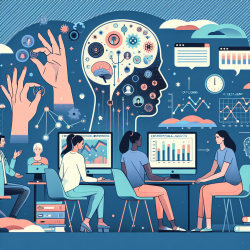Introduction: The Pandemic Lens
The COVID-19 pandemic has been a global disruptor, forcing us to reevaluate how we approach challenges across different timescales. The research article, "The Pandemic Lens: Focusing across Time Scales for Local-Global Sustainability," provides a framework for understanding and addressing these challenges through informed decision-making. This concept, known as the "Pandemic Lens," offers a unique perspective for practitioners, particularly those involved in speech-language pathology and online therapy services like TinyEYE, to enhance their skills and contribute to sustainable development.
Understanding the "Pandemic Lens"
The "Pandemic Lens" is a metaphorical tool that allows us to view the world through the lens of informed decision-making across various timescales. It emphasizes the importance of considering both short-term and long-term impacts when making decisions. This approach is crucial for practitioners who aim to create meaningful and lasting outcomes for children in their care.
By understanding the interconnectedness of global events and their local implications, practitioners can better navigate the complexities of their work environment. The "Pandemic Lens" encourages a holistic view, integrating scientific data, social sciences, and indigenous knowledge to inform decisions that benefit all stakeholders.
Implementing the "Pandemic Lens" in Practice
For speech-language pathologists and online therapy providers, implementing the "Pandemic Lens" involves several key strategies:
- Lifelong Learning: Embrace continuous education and adaptation to new technologies and methodologies. This ensures that practitioners remain at the forefront of their field and can provide the best possible care to their clients.
- Data-Driven Decisions: Utilize data and evidence-based practices to inform therapy approaches. This not only improves outcomes but also builds trust with clients and their families.
- Holistic Perspective: Consider the broader social, cultural, and environmental factors that may impact a child's development. This comprehensive approach allows for more tailored and effective interventions.
- Collaboration and Communication: Work collaboratively with other professionals, families, and communities to create a supportive network for children. Effective communication is key to understanding and addressing the unique needs of each child.
Encouraging Further Research
The "Pandemic Lens" is not a static concept; it evolves as new data and insights emerge. Practitioners are encouraged to engage in ongoing research and contribute to the body of knowledge in their field. By doing so, they can help shape the future of speech-language pathology and online therapy services, ensuring that they remain relevant and effective in a rapidly changing world.
Conclusion
Incorporating the "Pandemic Lens" into practice offers practitioners a powerful tool for navigating the complexities of their work. By embracing informed decision-making and a holistic perspective, they can create positive and lasting impacts on the children they serve. As we continue to learn from the challenges posed by the COVID-19 pandemic, the "Pandemic Lens" provides a valuable framework for fostering sustainable development at both local and global levels.
To read the original research paper, please follow this link: The Pandemic Lens: Focusing across Time Scales for Local-Global Sustainability.










